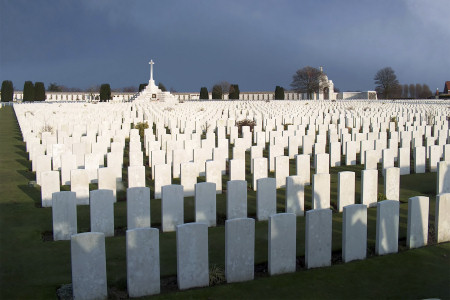‘Some Corner of a Foreign Field’: The Digitisation of War Graves
January 30th, 2011Blog; James FreemanBy the end of 1914, five months after Britain’s entry into the First World War, over a million men had volunteered to serve in the British Army. A year later, shortly before the introduction of the first of five Military Service Acts in January 1916 (which conscripted all unmarried men aged between 18 and 41), a further one and a half million had signed up. It seems particularly fitting, therefore, that a new project to commemorate those killed during the First World War and in conflicts since has been undertaken primarily by dedicated groups of volunteers.
The War Graves Photographic Project (WGPP) aims to digitally photograph ‘every war grave, individual memorial, MoD grave, and family memorial of serving military personnel from WWI to the present day’, and to correlate these images with the records held by the Commonwealth War Graves Commission (CWGC). At the time of writing, 1,599,630 names have been entered into their searchable database, and small images of graves or memorials are visible online free-of-charge.
Individually and collectively, the headstones which mark each burial site are material texts: the format in which they are engraved and their physical form are together illustrative of the particular ways in which twentieth- (and twenty-first) century society has chosen to remember its war dead. According to the guiding principles of the CWGC, the headstones are permanent and uniform; ‘no distinction [is] made according to military or civil rank, race or creed’. The aesthetic simplicity of their design was a necessary function where many thousands of graves were to be concentrated on one site – but is this the only reason for their uniformity?
The First World War had a profound effect on British social attitudes – universal male suffrage soon followed the Armistice – and perhaps such uniformity signifies an attempt to bestow on these fallen men an equality in their death which they did not enjoy in their lives. Or maybe there is a more radically pacifist message contained in these simple stones. Each headstone has been carved and engraved alike, is impeccably maintained and, when the forces of erosion demand it, re-engraved: ‘an eroded inscription is a brave man or woman forgotten and that is unacceptable …not a single sacrifice will be allowed to fade’. Their uniformity symbolises the universal value of human life, and in the meticulous acts of care bestowed upon these monuments we can see an ongoing enactment of public atonement for the waste of human life in four long and bloody years.
Most headstones from the First (and Second) World Wars – and the Cenotaph on Whitehall – were carved out of the distinctively bright white Portland stone (some have latterly been replaced by a similar but more hard-wearing white marble). Scattered across the graveyards of the British Isles, and concentrated in the cemeteries of Belgium and western France, they are instantly recognisable, and represent both a private memorial to an individual casualty, and a permanent public reminder of the conflict as a whole. At Tyne Cot cemetery near Passchendaele on the Ypres Salient (see picture), 12,000 or so headstones (over 8,000 of which are unnamed) stand in serried ranks before the Memorial to the Missing, upon which a further 35,000 names are engraved. Even in this one ‘corner of a foreign field’ – which is forever not just England, but also forever Canada, Australia, New Zealand, South Africa, West Indies, France, and even Germany too – the sense of the immensity of the slaughter is immediate and powerful. If this is just a small fraction of the war dead, one thinks, how horrifying was the whole?
